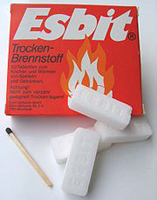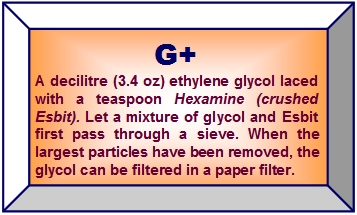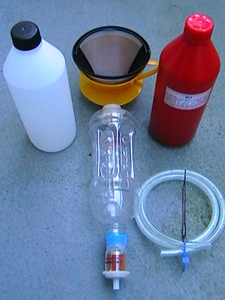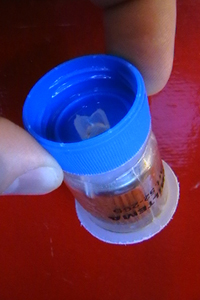Hmta is a white powder that emits an odor of urine. It is also a preservative and is then named E239. Fastest way to provide hmta is to extract it from Esbit tablets. One cans easily pulverizing tablets in a mortar. One tablet (4g) gives about 7-8 ml of powder which is enough for one and a half decilitre G+, thus can be 3 litres (0.79 gal) G+ produced by a box (20 tablets).

Add the powder in the glycol with the proportions; 5 ml powder (1 tsp) to 1 decilitre (3.38 oz) glycol - no more no less - in a container and stir it or shake it. Let it be for one or a few hours so that all hmta dissolves. Expect that some powder will not solve itself, because this is not hmta but probably a different salt and/or binders. Now, filtering the glycol (which contains unresolved powder) through a coffee filter (paper). By the filtering separated the unsolved powder from the hmta section - which moreover is dissolved in the glycol. When this is done, this glycol can considered as a special ingredient and can be called ”G+”.
G-plus:



 Materials for the manufacturing of G+
Materials for the manufacturing of G+To illustrate how to proceed have I chosen to present my self-built apparatus, which is a bit special. In the left white bottle, I mix the raw Esbit powder with glycols, which may stand for a while, plus that I can shake the bottle occasionally. Pictured at the far right shows how the coffee funnel with the coarse filter sits at the top of the image.
So you pour the contents of the white bottle in the funnel, then it run down to the sidebar - a Festis (Swedish still drink) bottle with holes in both ends. In connection with the Festis bottle is a fuel filter from an auto parts store - if that is called a fuel filter should no harmful particles get past? The stopper is glued on the fuel filter with silicone and hot melt. From the fuel filter have I chosen to have a long hose down to the red bottle (with prepared G+) - as a long hose provides suction power, will the speed of filtration increase. For comparison: In a chemistry lab exist similar glass funnels with a long straw. The speed depends on how clean the fuel filter is.
G+ works best when using glycol containing the substance sodium 2-ethylhexanoate. This is a metal salt of 2-ethylhexanoate acid (sometimes the manufacturers choose this acid 2-EHA instead of the sodium or potassium salt). Typically is glycol caring sodium 2-ethylhexanoate colored red but there are also blue products. However, it is more common for today's red to have potassium instead of the sodium variant, which does not function so well.
 Castrol Radicool SF is a genuine G12 (BASF name: G30) with sodium 2-ethylhexanoate
Castrol Radicool SF is a genuine G12 (BASF name: G30) with sodium 2-ethylhexanoate|
| |
|
| |




